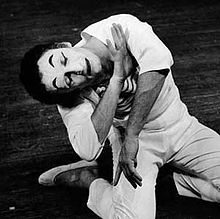Artistic expression

The artistic expression is a concept of the aesthetics and the theory of art . Here it describes the possibility of a work of art and its designed content having an effect on the recipient, created through the use of formal means, which allows the recipient to have an aesthetic experience and a sense experience at the same time or a sense experience as an aesthetic experience. It appeals as it emerges from their interaction on the part of the artist, with a communication offer to affects and emotions, but also to the reason of the recipient. It is an essential part of the substance of a work of art. The American art scholar Abraham Kaplan once described the relationship between expression, meaning and substance of a work of art, "into which all formal, sensual and expressive qualities are also incorporated": "Meaning becomes substance through expression; it gives the expression content and real reason . " The degree of intentionality of the artist and thus the hermeneutic leeway of the recipient and the effect on him can be very different and ultimately inexhaustible, which was emphasized by the theory of the open work of art Umberto Eco and the art theory of poststructuralism . Because the participation of the recipient, who brings his historical, social, biographical and aesthetic experiences into the encounter with the work of art, also influences its artistic expression in a specific way.
For a work of art e.g. B. In the fine arts , artistic expression is essential. It plays a special role in the performing arts, acting and music , including dance (especially ballet and expressive dance ) and opera .
In acting, he describes an important character skill of an actor or dancer as the embodiment of a personage , which includes linguistic articulation or gestures and facial expressions . It shows how an actor is absorbed in understanding roles . This can lead to a dilemma between the individual perception of the game by the presenter and the ideas of the director if he has a different conception of the presentation. When implementing a drama , a libretto or a script , there may also be a change in artistic expression depending on the performer's self-image. According to the traditional view , this ideally reproduces the template true to the work and brings the artistic expression inherent to it to the representation. On the other hand, the modern directorial theater takes the freedom to make far-reaching changes in order to update the template and to relate it to the social, political and aesthetic experiences of the recipients. In addition to the actual game, the means to do this include the stage design , costumes , video installations , acoustic effects and music. The text itself can also be adapted to the requirements that result from the intentions of the performers by deleting, adding or changing. Such interventions usually have far-reaching effects on artistic expression. The view goes even further that it is only the untrained game that guarantees free artistic expression.
In music, artistic expression comes into play in the musical performance of a musician .
Individual evidence
- ↑ Friedrich von Hausegger: Music as Expression [1887], ed. v. Elisabeth Kappel u. Andreas Dorschel . Universal Edition, Vienna - London - New York, 2010 ( studies on valuation research 50), passim.
- ↑ Abraham Kaplan: Referential Meaning in the Arts. In: Journal of Aesthetics and Art Criticism 12, 1953, pp. 457-474 (German: Reference in art). In: Dieter Henrich et al. (Ed.): Theorien der Kunst, Frankfurt am Main 1982, pp. 491–523, the quotation p. 500. Cf. Gereon Becht-Jördens, Peter M. Wehmeier: Picasso and the Christian Iconography. Mother relationship and artistic position. Dietrich Reimer, Berlin 2003, pp. 17–38.
- ↑ Friedrich von Hausegger: Music as Expression [1887], ed. v. Elisabeth Kappel u. Andreas Dorschel . Universal Edition, Vienna - London - New York, 2010 ( Studies on Valuation Research 50), pp. 93–99.
See also
- storm and stress
- romance
- genius
- creativity
- interpretation
- inspiration
- Rhetoric (oratory / eloquence)
- Expressive dance
literature
- Matthias Schmidt: Expression. In: Oesterreichisches Musiklexikon . Online edition, Vienna 2002 ff., ISBN 3-7001-3077-5 ; Print edition: Volume 1, Verlag der Österreichischen Akademie der Wissenschaften, Vienna 2002, ISBN 3-7001-3043-0 .